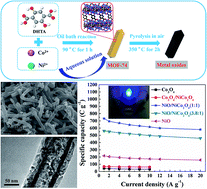MOF-74 derived porous hybrid metal oxide hollow nanowires for high-performance electrochemical energy storage†
Abstract
Metal–organic framework-derived materials have attracted much attention due to their great potential for applications in energy storage and conversion. Herein, we report a rational design and organic solvent-free synthesis of MOF-74 and derived hybrid metal oxide nanowires with hollow structure. The evolution process and mechanism of MOF-74 have been investigated by adjusting solvent compositions and Ni/Co ratios. Different phases of metal oxide nanowires can be tailored after calcinations, enabling the systematic investigation of the effect of different metal species counts on the electrochemical properties of hybrid metal oxide nanomaterials. Results indicate that the hybrid metal oxides exhibit obvious advantages compared with monometallic oxides of Co3O4 and NiO, and NiO/NiCo2O4 (1 : 1) with two mixed phases of NiCo2O4 and NiO exhibits a superior specific capacity of 732.0C g−1 at a current density of 1 A g−1 among three different hybrid metal oxides. Furthermore, an assembled asymmetric supercapacitor device achieves a high specific energy density of 46.9 W h kg−1 at a specific power density of 425.3 W kg−1 with excellent cycling performance. The as-prepared materials will be competitive and promising candidates for electrochemical energy storage and other applications.



 Please wait while we load your content...
Please wait while we load your content...